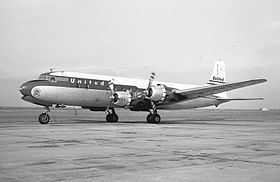Passengers 45 Aircraft type Douglas DC-6 Date 30 June 1951 Fatalities 50 (all) | Crew 5 Registration N37543 Operator United Airlines Passenger count 45 | |
 | ||
Site Crystal Mountain
west of Fort Collins,
Larimer County, Colorado
United States Aircraft name Mainliner Overland Trail Summary Controlled flight into terrain Locations Larimer County, Colorado, Crystal Mountain Similar United Airlines Flight 615, United Airlines Flight 608, United Airlines Flight 2860, United Airlines Flight 2885, Continental Airlines Flight 1883 | ||
On June 30, 1951, United Airlines Flight 610, a US transcontinental San Francisco–Oakland–Salt Lake City–Denver–Chicago service flown by the Douglas DC-6 aircraft Mainliner Overland Trail (registration N37543) crashed in Larimer County, northwest of Denver. All 50 on board (45 passengers and 5 crew) were killed.
Contents
Events leading up to crash
After completing its first two segments, Flight 610 departed Salt Lake City at 12:11 a.m. en route to its next destination of Denver. At around 1:47 a.m. Flight 610 reported to traffic control that it had passed the Cheyenne radio range station and requested lower altitude, which was granted to 8,500 feet.
At that point, Flight 610 was scheduled to make a right turn to intercept the 168 degree course line of the DEN low frequency range, and then to proceed to the WONT intersection, which was its next clearance limit. To intercept that course line, the plane turned to a heading of approximately 210 degrees, which was a proper intercept angle of almost 45 degrees. If the pilot had configured his audio selector switches properly, he would have been able to hear the aural Morse code identifier of "A", for the north side of that low frequency range, and then as he neared the course line itself, he would begin to hear the "N" identifier. That would be the signal that it was time to turn left again, and track the 168 degree course line to the WONT intersection. But, the plane never turned left again. Instead, it remained on that fatal 210 degree intercept heading, until impact.
As the plane descended to its cleared altitude, it continued its fatal heading towards high terrain. At 2:00 a.m. the DC-6 crashed into Crystal Mountain, about 50 miles NNW of Denver, skidding 690 feet to a stop, as it burst into flames.
Nature of error
It was conjectured that the pilot, in that darkened cockpit, might have selected the wrong audio frequency switches which, instead of giving him the appropriate Denver low frequency radio range signals, gave him the Denver Visual Audio Range (VAR) course signals. Both of those navigation ranges used the same audio Morse Code identifier of "DEN." And, both of those ranges needed to be received, to pinpoint the WONT intersection----the position to which the flight had been cleared by ATC. But, if the captain had selected those switches to incorrect positions, so that he was listening to the aural identifiers for the VAR course, then he would have heard only the "A" identifier, but never the "N" identifier, which was needed to tell him when it was time to turn left again.
After that investigation, the letter "V" was added to the "DEN" Morse code identifier for the VAR course, so that no pilot would ever again confuse it with the DEN low frequency range.
According to the July 1 edition of the "New York Times,' Robert M. Byers, a United Press International reporter, observed the wreckage from a plane and reported that the plane had gouged out a path 150 feet long and fifty feet wide through the heavy timber about 8,600 feet up Crystal Mountain. He also indicated that smoke rose from the gash torn in the trees by the splintering airliner.
